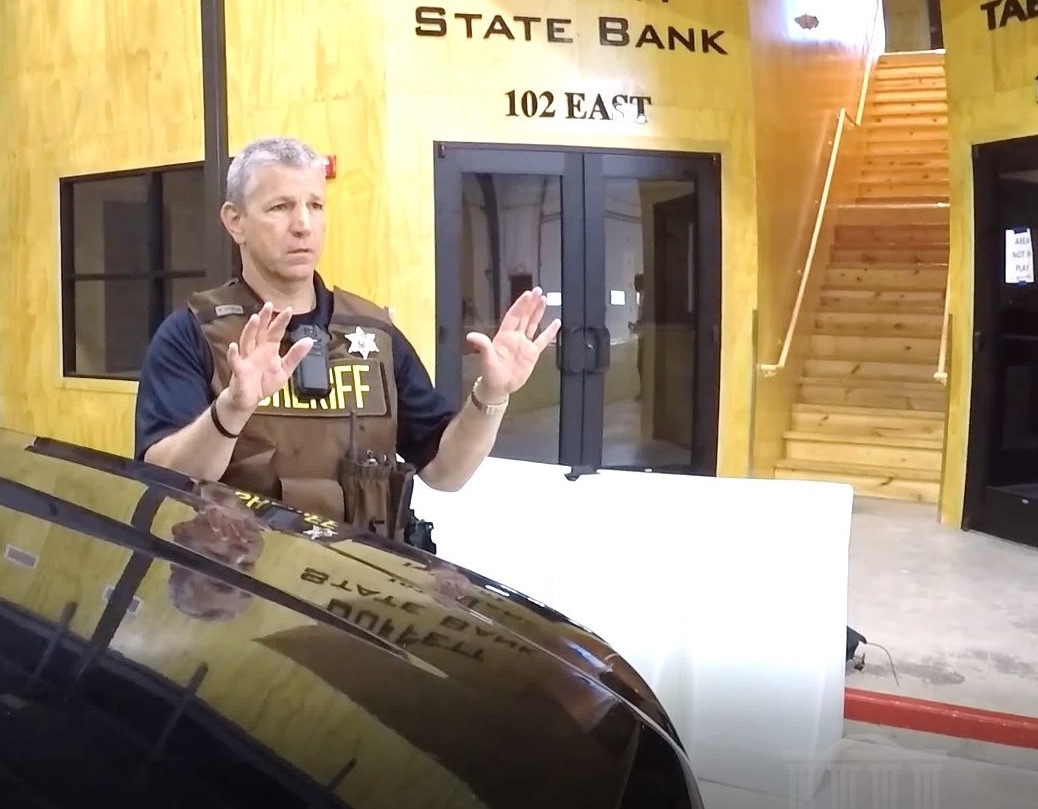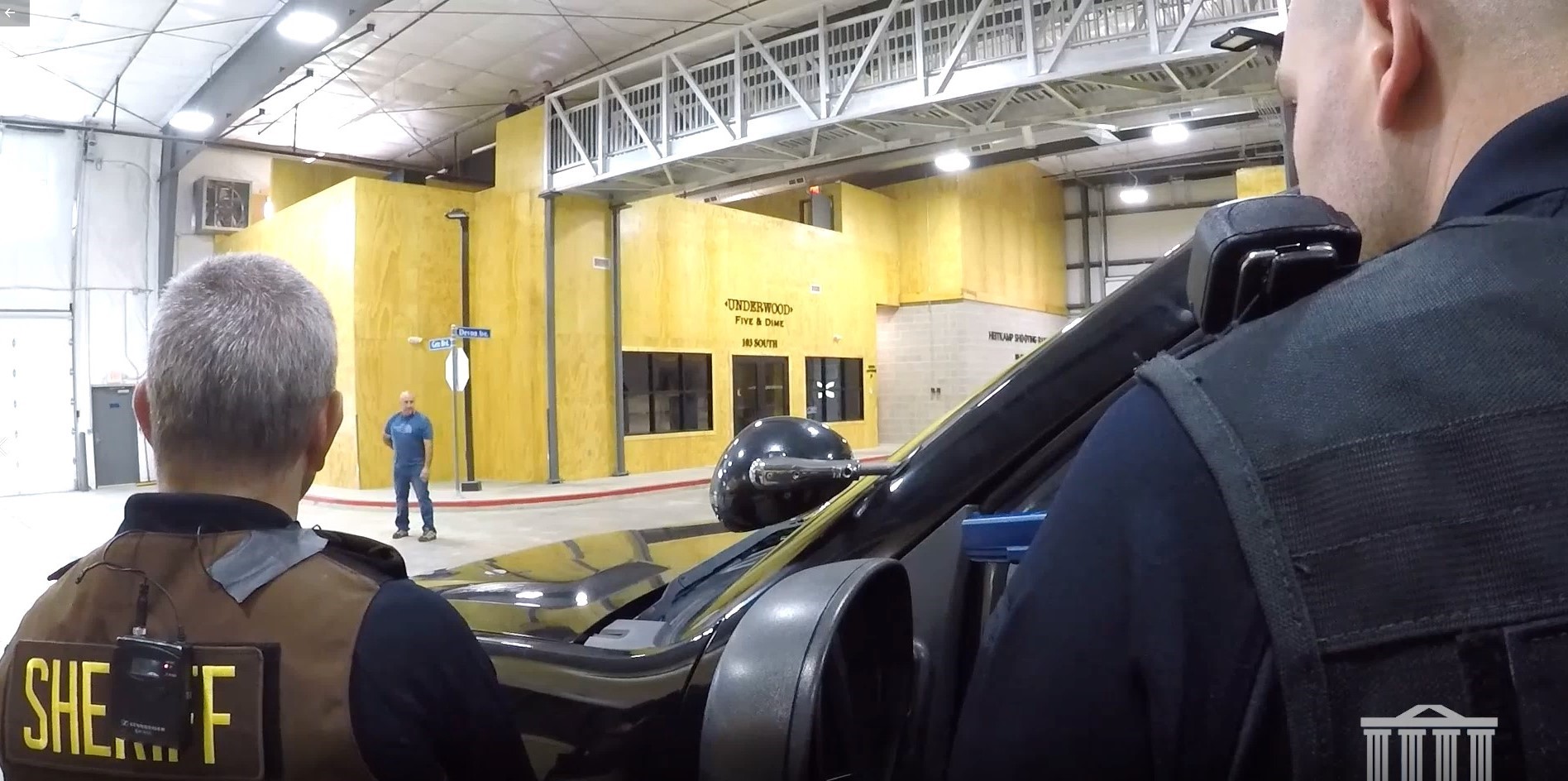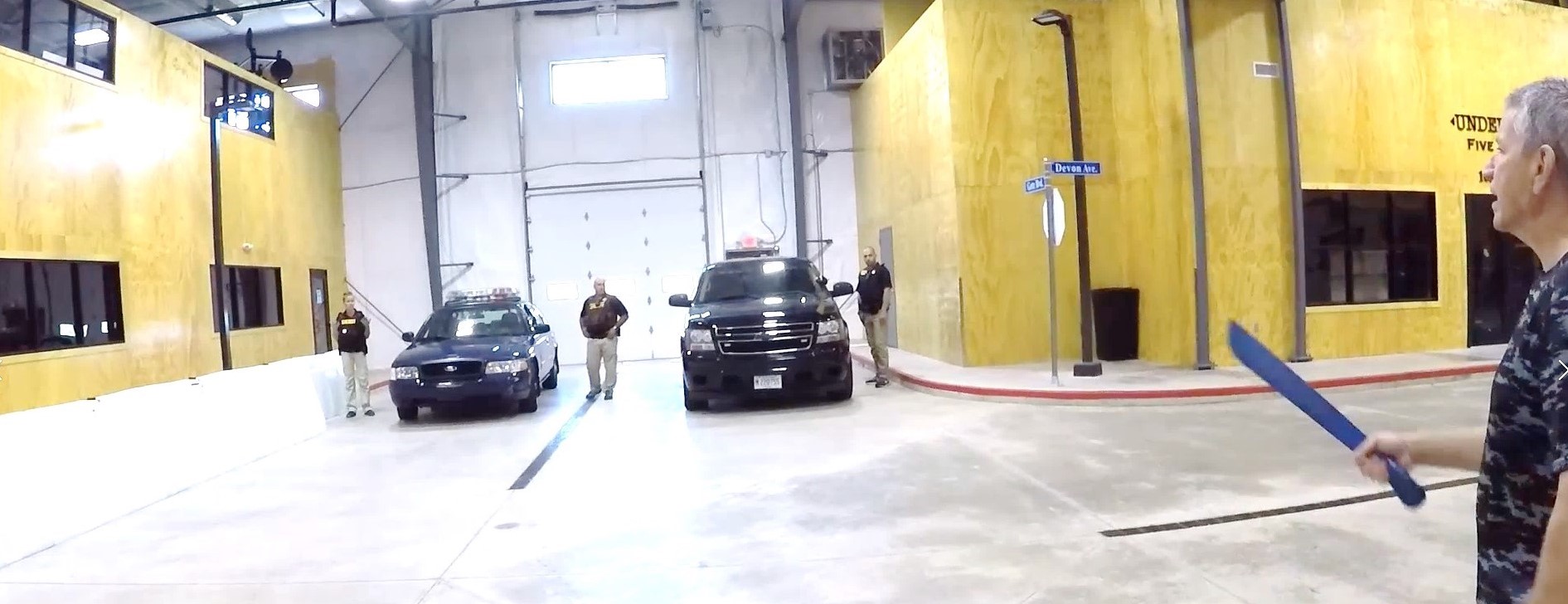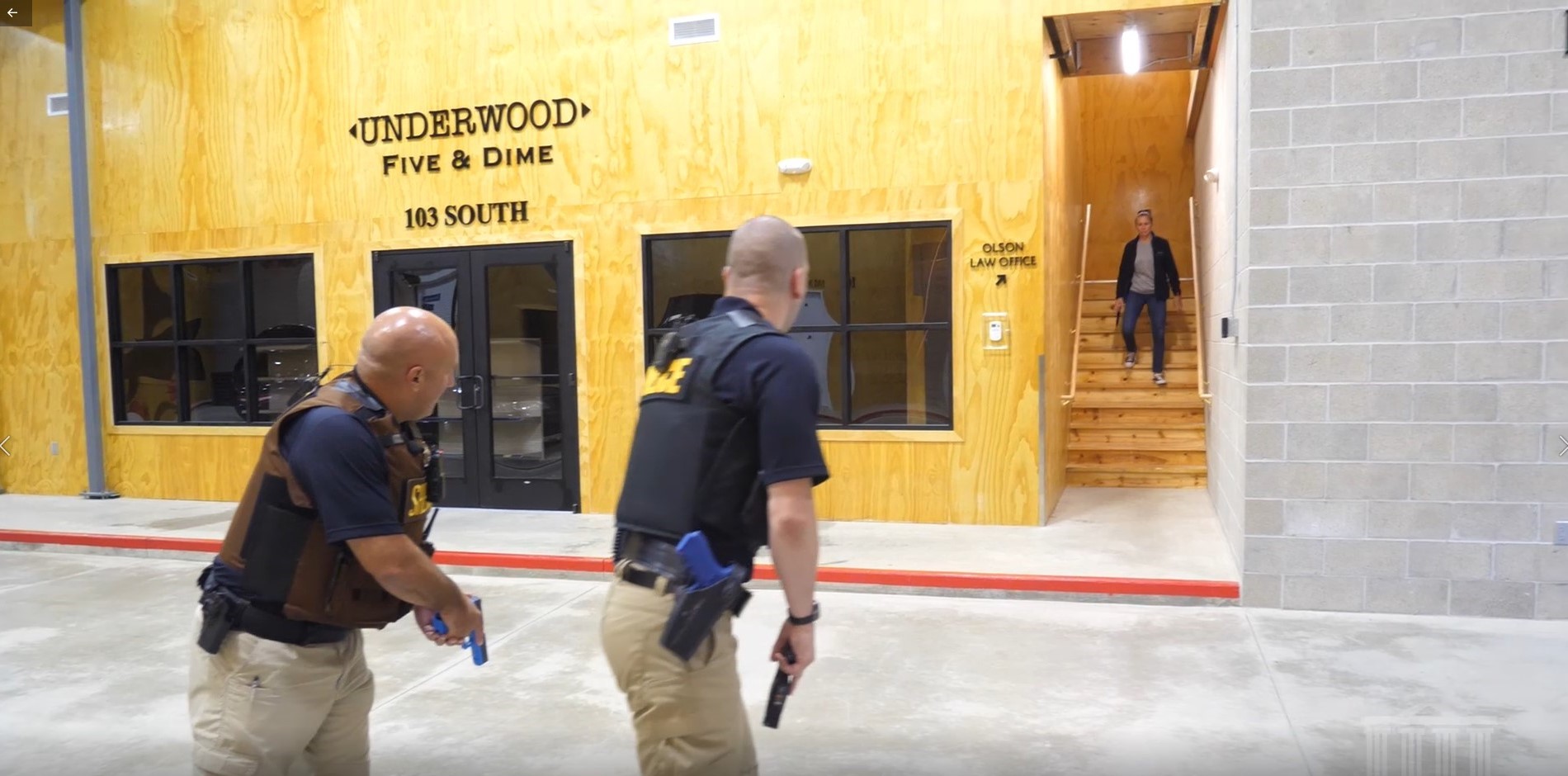Suicide by Cop: Protocol and Training GuideJump ahead to...
Click here for a printable PDF version of this guide
Introduction and ResearchThis Protocol and Training Guide is a tool for police officers to recognize and respond safely to incidents in which a person decides to attempt to die at the hands of a police officer. These encounters are called “Suicide by Cop” (SbC) incidents. Suicide by Cop incidents have been a concern in the policing profession for years, but PERF is unaware of any previous efforts to create training protocols on this topic. Many SbC incidents can be resolved without using lethal force against the suicidal person, and without endangering officers or the public. This Protocol and Training Guide is designed to bring the key elements of SbC training to all officers in departments of any size.
How this Training Guide was developedThis Training Guide was developed by the Police Executive Research Forum (PERF), a research organization with a membership of police chiefs, sheriffs, and other law enforcement leaders. The Guide was developed by PERF staff members working with police and sheriff’s officials, including experienced use-of-force trainers, specialized SWAT/ Emergency Service Unit personnel, and a psychologist with more than 40 years of experience working with police departments.
What is a Suicide by Cop incident?A Suicide by Cop incident is an encounter in which a suicidal person attempts to die by suicide by forcing a law enforcement officer to use lethal force.
How often do Suicide by Cop incidents occur?Fatal incidents: Each year from 2015 to 2018, there were approximately 900 to 1,000 fatal officer-involved shootings in the United States.1 And by various estimates, approximately 10 to 29 percent or more of officer-involved shootings involve Suicide by Cop incidents.2 Thus, it is reasonable to believe that there may be 100 or more fatal SbC incidents each year. Nonfatal incidents: A major research study in Los Angeles indicated that for every SbC incident that ended with the subject’s death, there were approximately 60 attempted SbC incidents, in which the police de-escalated the incident without using lethal force.3 Officer safety: One of the 419 SbC cases in the Los Angeles study involved an injury to an officer.4
How to recognize a SbC incidentSbC incidents should be handled differently from other types of calls, in order to protect everyone’s safety. Indicators of a possible SbC incident:
2 types of Suicide by Cop: Planned vs. SpontaneousPLANNED: A person has been thinking about suicide for some time, and decides that he wants to die. But he cannot bring himself to take his own life, so he creates an incident in which he attempts to force a police officer to use lethal force. One indicator of a planned SbC is that the subject immediately and repeatedly says “Shoot me” as soon as officers arrive. Or the subject may call 9-1-1, and when officers arrive, the subject points a firearm, knife, toy gun or starter pistol at officers. SPONTANEOUS: The subject was not thinking about committing Suicide by Cop, but decides to do so spontaneously, in some cases in response to how police handle the situation.
Why This Matters: To de-escalate an SbC situation, police need to understand what the suicidal person is thinking. “Understanding these concepts can help you decide what words you should say when you encounter a suicidal person,” said Dr. John Nicoletti, a police psychologist for more than 40 years. “You want to disrupt the person, but before you can choose your tools for disruption, you need to know which type of scenario you’re dealing with.”5
Demographics of persons in SbC incidents:The research on persons who attempted to commit Suicide by Cop in Los Angeles6 showed that:
Often, warning signs of Suicide by Cop are evident in the 9-1-1 call.In the study cited above, 28% of the 9-1-1 calls in SbC cases were classified as “mentally ill subject,” and another 23% were classified as “suicidal subject.” Thus, in at least 51% of the cases, there were indications of mental illness or possible suicidal behavior. Dispatchers should convey this important information about warning signs to the responding unit.
Responding to a possible SbC call: Your goal is to resolve it so that everyone goes home safely.In most SbC incidents, the subject does NOT have a firearm. In the Los Angeles study of 419 SbC incidents, 4% of the subjects had a firearm. Another 4% had a replica or fake weapon; and 5% had their hands in their pockets or otherwise appeared to possibly have a weapon. 16% of the subjects were armed with a knife.7
Special units in large police departments, such as the LAPD’s Mental Evaluation Unit and the NYPD’s Emergency Service Unit, successfully resolve many SbC incidents because they have received extensive training on mental illness and related issues. This Training Guide is designed to bring the key elements of SbC training to all officers in departments of any size.
Suicide by Cop Protocol for DispatchersThe key role of dispatchers working with officers: Providing critical informationDispatchers can make the difference between life and death in SbC incidents, because they can provide critical information:
Dispatchers should be trained to listen carefully for key words or phrases that may indicate a possible SbC incident, such as:
Dispatchers should work with responding officers to share information:
Suicide by Cop Protocol for Responding OfficersThe protocol for officers responding to a potential Suicide by Cop incident is a 3-step process:Step 1. Officers must make themselves safe and ensure public safety before they can do anything else. Step 2. Officers should be aware that pointing a gun at a potentially suicidal person will increase his or her anxiety and exacerbate the situation. Pointing a firearm elevates the subject’s level of anxiety and can make it impossible to communicate with the person. “If an officer says, ‘I’m here to help you,” but is pointing a firearm at the suicidal person, it’s conflicting messages. And people will always believe the nonverbal message,” said police psychologist Dr. John Nicoletti. If the potentially suicidal person is unarmed, or is armed with a knife, a blunt object, or other weapon but not a firearm, officers should position themselves at a great enough distance that they can engage the person in conversation, while still allowing time to react without the need for deadly force. Step 3. Officers must realize that their communications skills are their most effective tool in SbC incidents. Research indicates that communicating effectively with a suicidal person enables officers to resolve most incidents peacefully, without the need to deploy less-lethal weapons or other use of force.
Step 1: First, ensure your own safety and public safety.If subject has a firearm: This high-risk situation should be handled like other situations involving a subject with a firearm. Options are limited. Immediately take cover, use extreme caution, and warn arriving units. If subject has a knife: Maintain a safe distance, and use available cover, such as a vehicle or other large object, fence, etc., to keep the distance. If subject does not appear to have a weapon: Do not bark orders. Make small requests, one at a time.
Only when you have established a position that ensures your safety can you begin a process of asking the subject questions and looking for ways to de-escalate the situation.
Call in additional resources.The response to Suicide by Cop incidents is greatly improved when additional resources can be called to the scene, including:
The critical role of supervisorsSergeants (or other supervisors) have a key role in handling SbC incidents and many other types of calls that involve persons with a mental illness, drug or alcohol dependence, developmental disability, or other condition that can cause them to behave erratically or dangerously.
To increase safety, respond as a team.If multiple officers respond, everyone should have a defined role: Contact and cover: If there are two or more officers at the scene, one officer should be the contact (communications) officer and the other officer(s) should provide cover.
If the contact (communications) officer is unable to establish a connection with the subject and build trust, the two officers can switch roles.
Roles for additional officers as they arrive:
Natural leader: If there is no supervisor at the scene, a senior officer or “natural leader” should step up and take the role of managing the overall response.
Step 2: Officers should be aware that pointing a gun at a potentially suicidal person will increase his or her anxiety and exacerbate the situation.If a suicidal person has a firearm, officers have few options. They must focus on protecting public safety and their own safety. However, if you can establish that the suicidal person is unarmed, or is armed with a knife, a blunt object, or other weapon but not a firearm, and if you can use distance and cover to protect yourself, you will have a wider range of possible tactics. Pointing a firearm at a suicidal person can make it difficult to establish trust and communications. Pointing a gun at a suicidal person will increase his or her anxiety and exacerbate the situation. In some spontaneous SbC incidents, pointing a firearm at a person may actually be what causes him to think of Suicide by Cop as “a way out” of his unhappy life. Pointing a firearm can set in motion disastrous consequences. Ideally, if there are two or more officers at the scene, one officer can be the contact (communications) officer while the other officers provide cover. In some situations, after distance and cover have been established, officers should consider keeping their firearms unholstered and in a “low ready” position. A “low-ready” position will seem much less threatening to the suicidal person, while protecting officer safety.
Step 3: Communications are your most effective tool.New research conducted by the Los Angeles Police Department, working with California State University, found that a large majority of SbC incidents are resolved without use of any force.8 Police departments in Los Angeles and a number of other cities have units that have been specially trained to de-escalate incidents involving persons with mental illness, suicidal thoughts, and other conditions. The LAPD’s elite Mental Evaluation Unit (MEU) keeps hundreds of thousands of records on the incidents to which they respond. Between 2010 and 2015, MEU officers responded to 419 incidents that were classified as Suicide by Cop incidents.
The most effective tool that officers have is their communication skills. Talking to a suicidal person—establishing a personal connection and a relationship of trust—is the most effective way of defusing SbC incidents.
Prior to arriving at the scene:If there is no imminent danger, officers should consider gathering more information before arriving at the scene.

Distance + Cover = TimeSuccessful de-escalation of a Suicide by Cop incident requires that you have time to:
The objective is to reduce the subject’s level of anxiety and to buy time for further communications. To increase your available time:
Continue to gather information at the scene.If there are relatives, friends, or neighbors at the scene:
The answers to these questions will help determine your response.
Strategies for making a personal connection with a suicidal person
|
| Don't Say | Instead, Say |
| It’s not that bad. | I can see that it’s troubling you. |
| What you just told me isn’t real. (e.g., delusions) | What you told me must make you feel bad. Let’s talk about how to fix it. |
| Why do you feel bad? | Tell me about something good in your life, or something you’d like to do some day. |
| Calm down! | What can I do to help you? |
“When you’re asking questions, be sure to ask whether there is anything positive in this person’s life that you can talk to him about. When things are going well, what does this person like and enjoy? Those are the things you will want to know about when you try to establish a connection with him.”
—Dr. John Nicoletti, police psychologist
Make limited requests, one at a time.
A good way to establish trust is to make limited requests, one at a time.
If you can get a person to respond to one request, you establish a precedent of cooperation, and you can build on that with additional communications and requests.
- For example, “Hey, what’s going on? Can you do me a favor and move the knife away from your throat?”
- If the person takes the knife away from his throat, that is an important step forward, so thank him and make an empathetic comment before making another request. “Good, thank you. I appreciate you doing that for me. I hope you will trust me so we can talk a bit now. Do you think you could sit down on that bench for a minute and tell me what’s going on? I’d like to know what’s happening with you.”
Engage the suicidal person: “Put yourself in their shoes, and make it real.”
A suicidal person has a sense of helplessness and hopelessness.
Your goal is to try to disconnect those thoughts in the person’s brain and get him to focus on something positive or hopeful.
To show empathy, try to put yourself in the other person’s shoes.
- For example, if a suicidal person says he’s several thousands of dollars in debt, that may not seem like a large problem to you. But do not say “That doesn’t sound so bad.”
- Instead, ask yourself how you would feel if you were in a similar but more serious situation, such as losing your house and all of your financial assets. You’d feel terrible.
- How would you want someone to react to you in that situation?
- So you say, “It sounds like you’re going through a very rough time. What needs to happen to get you out of that hole? What can I do to help?”
“Cheerleading” doesn’t work.
- Saying “Oh, come on man, it’s isn’t that bad,” minimizes what they’re feeling, which doesn’t make them feel better.
How to make a connection with a person with a serious mental illness:
Persons who are psychotic, schizophrenic, or who have a delusional disorder present additional challenges.
Again, it helps to try to put yourself in their shoes.
- If someone is having visions and seeing snakes, it does no good to say, “There are no snakes here.” Their feelings will always be real to them.
- So imagine how you would feel if you were hiking and accidentally stepped into a nest of snakes. You’d be frightened and want to escape.
- So tell the schizophrenic person, “That must feel scary. I don’t see any snakes here, but I believe that you do, and it must be frightening for you. I’m here to help you.” And then try to change the subject to something positive.
- In other words, don’t ignore the person’s hallucinations, but don’t buy into them as if they’re real.
Rule of thumb for talking to persons with mental illness:
Be aware of the strengths and limitations of less-lethal weapons.
Less-lethal weapons, such as Electronic Control Weapons, beanbag shotguns, pepper spray, K-9, and hands-on use of force are sometimes used to resolve Suicide by Cop incidents.
- In the 2019 LAPD study, approximately 17 percent of more than 400 incidents in which police successfully de-escalated SbC incidents involved use of less-lethal weapons.
Officers should be aware that less-lethal tools often do not work as desired.
And they often escalate a situation drastically.
- By a number of estimates in different police agencies, Electronic Control Weapons fail to incapacitate the subject in approximately 40 percent of the incidents in which they are used.
- And worse, an unsuccessful use of an ECW usually angers the subject, ruining any trust you may have built, and in some cases causes the subject to physically attack the officers, raising the risks for everyone involved.
So if you are considering using a less-lethal weapon, before you use it, have a “Plan B” in mind for what you will do if the weapon does not achieve its purpose.
Critical awareness and brake pedal words: “Trying to see through the blur of everything that’s happening.”
Police psychology experts and trainers note that Suicide by Cop incidents can be very stressful for officers.
- In the words of one officer who successfully resolved a high-risk incident: “When you’re in a high-stress, high-risk situation with an unstable person who is making threats, it’s hard to see through the blur of everything that’s happening, and focus on everything that you’re trying to think about.”
- That is why scenario-based training for officers on SbC is designed to simulate a high level of tension.
- “Critical awareness” is the skill of focusing on what you need to notice in the moment, and tuning out distractions.
It is important for officers in SbC incidents to project calmness, because that tends to make the subject feel more calm.
Police psychology experts recommend that officers think of “brake pedal words” they can recite to themselves as they work through a tense incident.
- For example, one sergeant told PERF that her “brake pedal words” are “You’ve got this.”
- She said: “After you’ve done something many times, and practiced it and trained on it and done it for years, a moment comes when you realize that, even in all the heightened excitement of the moment, ‘You’ve got this.’ So that’s what I tell myself as I’m working through a difficult situation.”
Some officers are better than others at defusing critical incidents and reducing anxiety in persons with mental illness or other conditions.
In almost every police or sheriff’s department, it is understood that some officers and deputies are better than others at de-escalation and handling critical incidents.
- For example, a sergeant hears a radio call about a potential SbC incident or other sensitive situation, and realizes that a certain officer is responding who is not strong on de-escalation. So the sergeant rushes to the scene to take control of it.
- In some departments, supervisors tell stories about incidents that were being handled well and were under control, until a certain officer showed up, acted precipitously, and ruined the good work that was being done.
The solution, experts agreed, is that a skilled person needs to be in charge to control the response, and that person needs to have the awareness and ability to implement the strategies outlined in this Training Guide.
“You need a team approach,” one experienced sergeant said. “This is why SWAT teams have the success they do. They are trained as teams. In SWAT, you don’t have one person going one way while the other seven go the other way.”
- However, SWAT teams do not respond to most incidents, so patrol officers must also be trained to use the strategies for working together to de-escalate a situation:
- Team approach
- Slowing incidents down
- The importance of communications
- Using distance and cover to buy time for further communications.
The ICAT Context
This Training Guide is part of the Police Executive Research Forum’s ICAT training program—Integrating Communications, Assessment, and Tactics. ICAT, which was released by PERF in 2016, provides first responding officers with tools, skills, and options for successfully and safely defusing a wide range of critical incidents.
ICAT was developed with input from hundreds of police professionals across the United States, and has been implemented by more than 65 departments in 27 states.9
Most of the basic elements of ICAT apply directly to Suicide by Cop incidents, including the Critical Decision-Making Model, Crisis Recognition, Tactical Communications, and Operational Tactics.
Focusing ICAT principles on the particular dynamics of Suicide by Cop incidents: This SbC Training Guide provides more in-depth analysis of Suicide by Cop incidents, and more specific guidance about how officers often can safely defuse such incidents.
Scenarios
The videos below depict scenario-based training sessions in which police officers from a number of agencies respond to simulated SbC incidents. After each scenario is concluded, the officers discuss how they responded with PERF’s ICAT trainers and with police psychologist Dr. John Nicoletti. The discussions include aspects of the response that were handled well, as well as officers’ actions that could have been better, particularly regarding the specific words and phrases that officers should use to calm a suicidal person down and obtain compliance without use of lethal force.
Scenario #1
Scenario #2
PERF Members Discuss Suicide by Cop at 2019 PERF Town Hall Meeting at IACP
Acknowledgments
Many of the concepts in this Protocol and Training Guide were developed at a two-day meeting at the Macon County, IL Law Enforcement Training Center in August 2019. Participants included:
- Sheriff Timothy K. Cameron, St. Mary’s County, MD
- Capt. Kevin Lutz, Camden County, NJ Police Department
- Lt. Dan Warren, Riverside, CA Police Department
- Lt. Shelly Katkowski, Burlington, NC Police Department
- Sgt. John Flynn, New York City Police Department, Emergency Service Unit
- Officer Josh Hilling, Glendale, OH Police Department
- Dr. John Nicoletti, Partner, Nicoletti-Flater Associates
- Howard Buffett, Undersheriff, Macon County, IL Sheriff’s Office
PERF is grateful to the Macon County Law Enforcement Training Center for providing the venue for discussions and for recording scenario-based training exercises.
Thanks also go to Herard Media Company for videography, and to PERF staff members: Director for the Center of Applied Research and Management Tom Wilson; Senior Associate Dan Alioto; Research Assistant Adam Kass; and Communications Director Craig Fischer.
Chuck Wexler Executive Director
Endnotes
- “Fatal Force.” The Washington Post. https://www.washingtonpost.com/graphics/2019/national/police-shootings-2019/
- Patton, Christina L. and Fremouw, William J. “Examining ‘suicide by cop’: A critical review of the literature. Aggression and Violent Behavior, 27 (2016) 107-120.
- “Suicide by Cop: A New Perspective on an Old Phenomenon.” Alejandra Jordan, Nancy R. Panza, and Charles Dempsey. Police Quarterly. (2019). (forthcoming)
- Ibid.
- Discussions at PERF’s Suicide by Cop meeting, August 2019.
- “Suicide by Cop: A New Perspective on an Old Phenomenon.” Alejandra Jordan, Nancy R. Panza, and Charles Dempsey. Police Quarterly. (2019). (forthcoming)
- Ibid.
- Ibid.
- “Agencies Implementing ICAT.” https://www.policeforum. org/icat-agencies


